Check out our latest blog posts!
Learn how to improve your skill set or discover the latest news in the grooming industry.

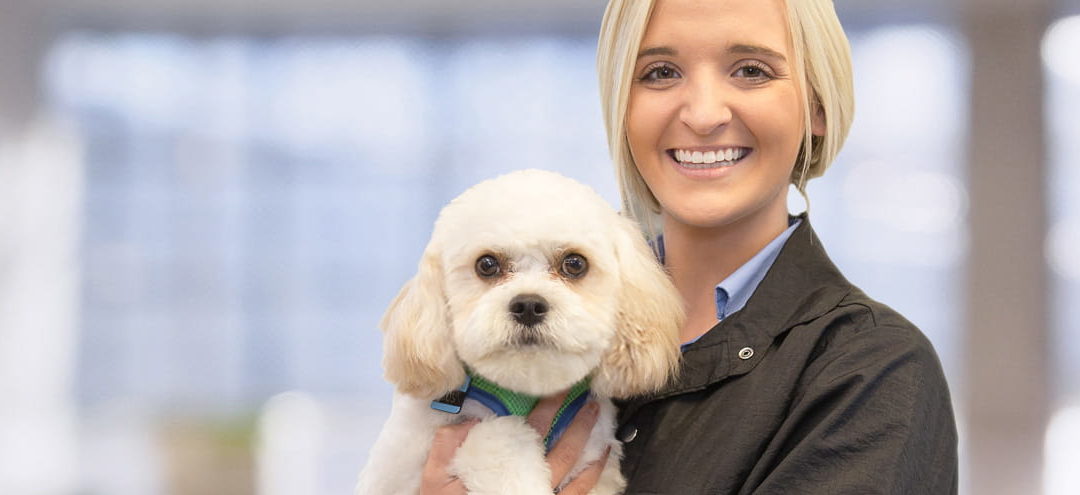
Check out our latest blog posts!
Learn how to improve your skill set or discover the latest news in the grooming industry.
When a student graduates from The Paragon School of Pet Grooming, I love to hear about their success stories down the road. They might work for someone else or work for themselves. They love what they’re doing and their careers are thriving. But what makes those graduates successful?
For many of them, it might not be what you think.
We all have good friends. When you think about those friends, what traits draw you to them?
 My good friends are honest, dependable, self-confident, empathetic, and are good listeners. They have integrity. I enjoy being around them.
My good friends are honest, dependable, self-confident, empathetic, and are good listeners. They have integrity. I enjoy being around them.
Bottom line, I trust them.
Not every groomer needs to be an all-star stylist to succeed. However, having repeat clientele is the lifeblood of any business. It does not matter if you are a solo groomer or work with a team of pet stylists with a support staff. Getting customers to come back on a regular basis pays the bills.
We are not in the business of washing and styling pets. We are in the trust business. For many of the clients that we deal with on a regular basis, their pets are an extension of their family.
I’m not a parent but if I were, I would never leave my child anywhere I felt apprehensive about the facility, the people, or about any part of the service. Most of our clients feel the same way about their fur babies. If you are going to be successful, your clients need to trust you.
To be a successful pet groomer or stylist, you need to have repeat clientele. Repeat clients are attracted to the same types of characteristics as your good friends. When you get others to trust you, it’s easier to grow your clientele and/or your business. It allows you to give all your clients and the pets exceptional service.
Unfortunately, trust is fragile. If you lose it, it can be very difficult, if not impossible, to restore it.
You can’t fake a genuine relationship built on trust. The same characteristics that build a good friendship will build strong relationships with your clients and their pets.
Trust can take a long time to build. Yet it can take only a moment to weaken or disappear because of one senseless act. Without trust, you don’t have a business – or a job.
Trust keeps clients coming back. Repeat clients keep your business healthy. Take the time to build trust and strengthen relationships with your customers – you’ll be amazed at the result!
Happy trimming!
Melissa
 Do you agree with this post? Jump on the Learn2GroomDogs.com Facebook page and tell us why or why not.
Do you agree with this post? Jump on the Learn2GroomDogs.com Facebook page and tell us why or why not.
It’s an amazing honor to receive the Barkleigh Honors Award for Website of the Year. We are thankful beyond words to be nominated among such devoted and talented people. Thank you to Barkleigh for your recognition and for the tireless work you do every day to improve our industry for all groomers and the pets entrusted to us.
 Receiving this award is both humbling and inspiring. We created Learn2GroomDogs.com to help people who love working with pets become the groomers and stylists they’ve always wanted to be. We’re so grateful to be part of an industry that values education as well as professional and personal growth. Thanks to our subscribers, we’re more excited and motivated than ever to keep bringing you the tools and materials you need to make your lives better and improve the safety and well-being of pets everywhere.
Receiving this award is both humbling and inspiring. We created Learn2GroomDogs.com to help people who love working with pets become the groomers and stylists they’ve always wanted to be. We’re so grateful to be part of an industry that values education as well as professional and personal growth. Thanks to our subscribers, we’re more excited and motivated than ever to keep bringing you the tools and materials you need to make your lives better and improve the safety and well-being of pets everywhere.
This was so much more than the four of us could achieve alone. Helping people is our passion and you have always been the driving force behind everything we do.
Thank you to our dedicated team, our amazing Training Partners, and our subscribers for your feedback, insight, and support. This award belongs to all of you, as well. We wouldn’t be here if it weren’t for all of you. Thank you for being part of our family.
I often say there are shades of gray in pet grooming.
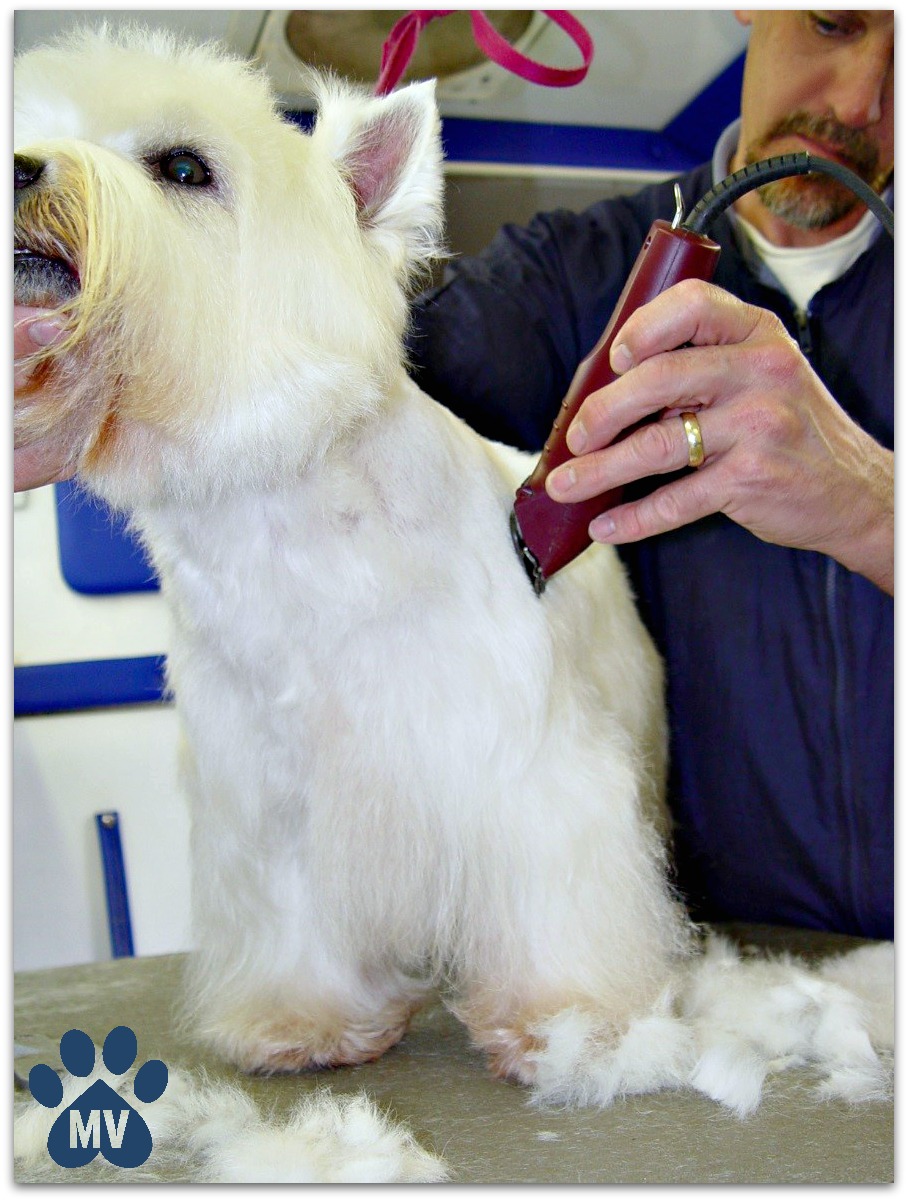 How many dogs a day you should groom is one of the BIG gray areas! The number will be different for everybody. Some people feel overwhelmed grooming even three dogs in a full day. Other people can do 16 while barely breaking a sweat.
How many dogs a day you should groom is one of the BIG gray areas! The number will be different for everybody. Some people feel overwhelmed grooming even three dogs in a full day. Other people can do 16 while barely breaking a sweat.
Here are just a handful of the scenarios affecting the number of dogs that might be groomed in a day.
I’m sure you could add a few more to this list!
Typically, when someone first graduates from grooming school or is new to the industry, productivity is not high on their skill list. Rather, their focus is on thoroughness, quality, and safety.
New groomers will improve their speed as they develop skills and confidence. They need experience. They need coaching. They need guidance to create an effective grooming system. The system allows thoroughness while enhancing the quality of their work and the pace in which they do it.
If you’re a seasoned pet stylist, you’ve learned many of the tricks that allow you to be efficient. You’ve learned how to quickly assess a pet and easily determine its grooming needs. You are thorough. You work safely. You have a strong base of repeat customers.
Over the years I’ve seen beginners struggle to get through three dogs. I’ve seen highly efficient, seasoned stylists get through 16 or more dogs in the single day and still have the time and energy to have a little “me time” that evening. Where do you fall on the scale? Where would you like to be?
Being able to work quickly and skillfully can also be impacted by the layout of your work space. Are you set up for maximum efficiency? A bad layout will add unnecessary footsteps to your day and waste your time and energy.
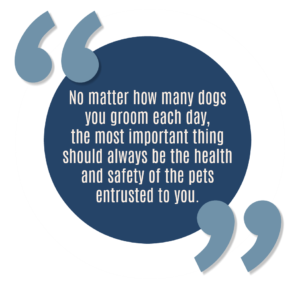 Your equipment, tools, and products will also help or hurt you. Many products will enhance your speed and the quality of your final product. Do you have access to high-quality, time-saving, products and tools? When used correctly, they are well worth the investment and can help you groom more pets efficiently.
Your equipment, tools, and products will also help or hurt you. Many products will enhance your speed and the quality of your final product. Do you have access to high-quality, time-saving, products and tools? When used correctly, they are well worth the investment and can help you groom more pets efficiently.
If you are a solo stylist either in your own salon or mobile setting, 6 to 8 dogs will likely be your maximum. In addition to grooming pets, independent business owners have a wide range of duties and responsibilities. They are the receptionist, the bookkeeper, the marketer, the janitor, and the record keeper – along with every other task it takes to run a successful business. If you are a mobile stylist, you also have driving and van maintenance added to your list of responsibilities.
Efficiency comes into play when pet grooming establishments start building a team. You cannot build a successful business or team with inefficient team members. Inefficient teams will not be able to groom as many pets as their efficient counterparts.
Financial need affects dog numbers. To get a decent paycheck, everyone needs to pull their weight. If you are hired onto a team or work with an assistant, you will have quotas to meet. Some quotas are determined by dog numbers. Other businesses use financial sales volume. Both help determine how many dogs are groomed each day.
Typically, once you start working with others, dog volume increases. In most salons, a team of people working together will be expected to do a minimum of eight dogs a day or more. When you’re working within a team, everybody has a specialty. Each person can focus on what they do best, whether it’s customer service, bathing and drying, or pet trimming and styling. If you have an assistant doing the bathing and drying for you, the number of pets might jump from 6-8 to 12-14. Let’s face it – bathing and drying dogs takes time! If a shop has a good bather/prepper, you can easily groom more pets in a day.
The type of trim combined with the sizes of dogs being done will make a huge difference in how many pets can be done each day. A #7F All on a six-week regular Shih Tzu is much different from a longer guard comb trim with stylized scissored legs. What happens if you increase the size of the dog? Larger dogs simply take much more time. To me, a Doodle is the equivalent of two or three smaller dogs, depending on the type of haircut it is getting.
For many pet professionals, WHY you groom pets will also influence how many dogs you groom in a day. One of the amazing things about our industry is we all love dogs. There are those who really enjoy taking their time with the grooming process and will groom fewer pets. There are those who will try to help as many pets as they can in a single day. Others enjoy the creativity. Some enjoy the flexibility the career offers while others are motivated by the career opportunities. There are also groomers that simply enjoy earning a living by doing something they love.
How many dogs should you groom each day? There are lots of gray areas so there is no right answer. Whatever your motivation, no matter how many dogs you groom each day, the most important thing should always be the health and safety of the pets entrusted to you.
Happy trimming!
Melissa
 Do you agree with this post? Jump on the Learn2GroomDogs.com Facebook page and tell us why or why not.
Do you agree with this post? Jump on the Learn2GroomDogs.com Facebook page and tell us why or why not.
Growing your business starts with two simple equations:
 If you want your business to thrive in any economy, you need insurance – and repeat business is your insurance plan.
If you want your business to thrive in any economy, you need insurance – and repeat business is your insurance plan.
During my recent lecture about client management at a large trade show, an audience member said something so amazing I knew I had to share it with you. I wish I had caught her name so I could give her full credit for her brilliant idea.
Professional groomers are always busy when the weather is warm. Most of us are booking out two to three weeks (or more) in advance. When the weather is toasty, people always want their pets groomed. The dogs are hot, dirty, and stinky. Even the once or twice per year clients start calling.
 Where are those clients during the slower times when your appointment book needs filling? Those are the times when you wish you had more regular clients that book consistently every few weeks.
Where are those clients during the slower times when your appointment book needs filling? Those are the times when you wish you had more regular clients that book consistently every few weeks.
Those regular clients are your bread-and-butter. They keep your bills paid and food on your table. They are the ones you can count on. Any successful grooming salon wants a roster full of regular customers and the time to look for them is not when you’re slow. You need to get them while you’re at your busiest.
It’s not as crazy or as impossible as it sounds.
Remember that brilliant audience member? She said she always leaves at least one opening per day to accommodate walk-ins and new clients.
Some of you are shaking your heads. Why would you leave an appointment slot empty when you can fill it with a regular client? You’re probably thinking that you’re losing easy money.
Here’s where that insurance plan idea kicks in. The problem isn’t being booked out when the weather is nice. The problem is that you need to be booked no matter what kind of weather you’re having. You do that by adding clients – and when are new clients calling? The same time as everyone else.
A new client will not wait 2 or 3 weeks to book an appointment with you. They will just move on to the next groomer who set that time aside, just waiting for that client to call.
If you’ve nurtured a relationship with your regulars, they will wait for you. They love you. Their pets love you. Making sure to pre-book their next appointment ensures they get premier treatment and the best appointment times. The long-term investment you’ve made in keeping these customers happy will now start to pay off.
Setting aside those five slots a week is how that lady in the audience maintains a constant stream of new clients. These walk-ins become customers that she can educate and count on during the slower times of the year. As she builds up her regular clientele, she can eliminate the once or twice a year dogs. After all, wouldn’t you rather work on a super regular client instead of a twice a year outdoor farm dog?
 $100 for a once a year farm dog seems like a lot of money – but is it?
$100 for a once a year farm dog seems like a lot of money – but is it?
Let’s say you have a 6-week regular client who pays $50 per visit. That’s half of the once a year farm dog. You are going to see that client eight to nine times a year. On an annual basis, you’re going to earn between $400 and $450 for that single client.
The farm dog? You will earn $100. $100 you can’t count on next month or next year.
Which would you rather do?
If you do not make time in your schedule to take on new customers, you might miss out on adding a valuable client that will keep your bills paid when it’s slow. This client could make the difference between working or being sent home because you don’t have any dogs to groom.
Which salon would you rather work at?
As a bonus, making room in an already packed schedule allows you some wiggle room. Maybe you don’t have a walk-in on that day. Or maybe you don’t have a new customer calling to book an appointment. That open slot allows you a little breathing room. Probably at a time when you most need it.
Do you have to take every first-time appointment or walk-in coming through your doors? Absolutely not.
I would ask for some critical information before you get too far into the conversation. Of course, the customer will want to know the price. That gives you the opportunity to learn the breed, the age, the size, the coat condition, and how long it’s been since his last professional grooming. These questions will help you determine whether you should book the appointment. Trust your gut with what the client says. It’s your appointment book.
When you do make room for a new client, make sure you also take the time to educate them. Most clients don’t know how frequently they should have their dogs (or cats) groomed. Talk to them about their lifestyle and how much maintenance they’re willing to do between appointments. Talk about what you can do for them as well their limitations based on the condition of the pet. Custom create a regular schedule that will suit their needs and keep their pet looking and feeling its best.
Will you get it right every time? No. But if you don’t make room for prospective new customers during your busiest times, you won’t have regular clients to carry you through when it’s slow.
Happy trimming!
Melissa
 Do you agree with this post? Jump on the Learn2GroomDogs.com Facebook page and tell us why or why not.
Do you agree with this post? Jump on the Learn2GroomDogs.com Facebook page and tell us why or why not.
 When you attend trade shows and clinics, preparing in advance can help you make the most of this experience. Seminars are a great way to improve your skills and recharge your batteries. Meeting your mentors and soaking up their knowledge is a fantastic opportunity, and if you can see and hear them in action, it maximizes the experience. When you know what you need and what you hope to get out of the session, you can better prepare yourself to squeeze out as much as you can from your time together.
When you attend trade shows and clinics, preparing in advance can help you make the most of this experience. Seminars are a great way to improve your skills and recharge your batteries. Meeting your mentors and soaking up their knowledge is a fantastic opportunity, and if you can see and hear them in action, it maximizes the experience. When you know what you need and what you hope to get out of the session, you can better prepare yourself to squeeze out as much as you can from your time together.
 If you are young and fresh to the industry, the amount of information that you get can be intimidating. Listen, take notes, and soak up every bit of knowledge that you can. Sometimes that may mean suspending what you know in order to make room for something new. Trying new techniques or ideas can be uncomfortable just because you’ve never tried it before. Keeping an open mind enables you to break from your routine to get different results. With time and practice, the awkwardness goes away and you become more efficient. Remember: having more tools, techniques, and knowledge allows you to have multiple approaches to a problem.
If you are young and fresh to the industry, the amount of information that you get can be intimidating. Listen, take notes, and soak up every bit of knowledge that you can. Sometimes that may mean suspending what you know in order to make room for something new. Trying new techniques or ideas can be uncomfortable just because you’ve never tried it before. Keeping an open mind enables you to break from your routine to get different results. With time and practice, the awkwardness goes away and you become more efficient. Remember: having more tools, techniques, and knowledge allows you to have multiple approaches to a problem.
 Many trainers at these sessions have limited time. They are often rushing from one obligation to another – judging competitions, speaking in seminars, or providing hands-on clinics. If they can, many will take the time to answer your questions. If you know what you need to ask, it helps you make the best use of the brief time you may have together. Be prepared – write down your questions in advance so you don’t forget something important or stumble over your words. Being ready to participate in the learning experience helps you make the best use of the session – and the presenter will respect you for it.
Many trainers at these sessions have limited time. They are often rushing from one obligation to another – judging competitions, speaking in seminars, or providing hands-on clinics. If they can, many will take the time to answer your questions. If you know what you need to ask, it helps you make the best use of the brief time you may have together. Be prepared – write down your questions in advance so you don’t forget something important or stumble over your words. Being ready to participate in the learning experience helps you make the best use of the session – and the presenter will respect you for it.
 With so much to see and do at trade shows, it’s easy to feel overwhelmed. Break out the catalog and study the floor plan before you arrive. Map out your plan of attack to make sure you get to everything you need to see. Some shows have free apps you can download to help make the most out of your experience. Know the schedule of events so you don’t miss that speaker you’ve been hoping to see. Sometimes it’s good to go to shows like this with a friend – divide and conquer, then compare notes later.
With so much to see and do at trade shows, it’s easy to feel overwhelmed. Break out the catalog and study the floor plan before you arrive. Map out your plan of attack to make sure you get to everything you need to see. Some shows have free apps you can download to help make the most out of your experience. Know the schedule of events so you don’t miss that speaker you’ve been hoping to see. Sometimes it’s good to go to shows like this with a friend – divide and conquer, then compare notes later.
As your knowledge and skills advance, the clinics won’t be as daunting. They will become a great way for you to fine-tune your skills. You can begin to network and exchange thoughts with others in the industry who can provide insight when you need it. Plus, these types of functions are a great way to invigorate your career.
These principles remain valid for many forms of advanced learning in the pet grooming industry. Maybe you don’t have the opportunity to do a hands-on training session. There is a wealth of information to learn from these all-star pet stylists. You might be in the audience at a trade show, pet grooming competition or watching a grooming video lesson featuring one of these top stylists. The better you can execute the core skills with your everyday grooming, the easier it will be to successfully transfer their lessons to your own grooming table.
If you are not as accomplished as these award-winning and highly successful pet groomers are – take note. You can learn a lot from their well-developed skills. Learning new skills, tips, and tricks make grooming pets all that more fun!
Happy trimming!
Melissa
 Why do you attend trade shows? How do you make sure you get your money’s worth? Jump on the Learn2GroomDogs.com Facebook page and tell us about it.
Why do you attend trade shows? How do you make sure you get your money’s worth? Jump on the Learn2GroomDogs.com Facebook page and tell us about it.
 Imagine that you have been in the boarding kennel and grooming business for over 16 years. You have three groomers, three kennel techs, and one bather depending on your business for their livelihood. On August 25, 2017 Hurricane Harvey would come ashore and life as you know it would be changed forever. Your hometown of Lumberton, Texas, is now completely underwater.
Imagine that you have been in the boarding kennel and grooming business for over 16 years. You have three groomers, three kennel techs, and one bather depending on your business for their livelihood. On August 25, 2017 Hurricane Harvey would come ashore and life as you know it would be changed forever. Your hometown of Lumberton, Texas, is now completely underwater.
This is a real scenario for many groomers who – like 80% of Texans – did not have flood insurance and have lost absolutely everything. The people in this story are real and they are currently unemployed after the destruction of Hurricane Harvey.
That’s just one grooming-related family affected by this hurricane. There are hundreds more experiencing very similar situations.
Currently, a second hurricane is bearing down on the United States. Experts say it is still too early to determine exactly where and how strong Hurricane Irma will be. It is projected to be a Category 5 hurricane as it hits Puerto Rico, which is directly in Irma’s path.
With any tragedy comes the need for people to reach out and help others. Finding the right avenue(s) to contribute can be daunting. Unfortunately, there will be those who take unfair advantage of the situation. It is for this reason the Groomers Emergency Assistance Fund (GEAF) was formed. The GEAF is an IRS registered non-profit 501c (3) Corporation.
The GEAF grew from the turmoil caused by superstorm Sandy. Local groomers that were unaffected by the tragedy helped those who were less fortunate. Groomers and industry-related companies across the country contributed what they could. They helped both financially and with equipment donations. Donors were confident that their efforts would go directly into the hands of a groomer. The GEAF had a direct impact on getting those affected by Hurricane Sandy up and running again.
 The goal of the GEAF is to help relieve the immediate needs of groomers in distress. These are groomers who may have lost their businesses, equipment, or even their homes in the path of tragedy. GEAF helps groomers in need within the continental United States plus Alaska, Hawaii, and Puerto Rico.
The goal of the GEAF is to help relieve the immediate needs of groomers in distress. These are groomers who may have lost their businesses, equipment, or even their homes in the path of tragedy. GEAF helps groomers in need within the continental United States plus Alaska, Hawaii, and Puerto Rico.
Applicants are vetted to ensure they will qualify for aid. Insurance policies are reviewed and volunteers help the applicants get the most out of their policies. They are walked through FEMA applications by professional volunteers.
We need your help to make their efforts go even further!
If every groomer and salon owner reading this would donate the price of just one groom a day or even a week, imagine the impact it would have! GEAF could help scores of pet professionals. Remember, every little bit helps.
If you’re able, we’d love it if you could donate even $5.00. The greater your generosity, the larger the impact GEAF can make. All donations are tax-deductible under the 501c (3) Corporation classification.
Thank you in advance for your contribution. Your donation will go toward putting food on tables, roofs over heads, and groomers back to work.
GEAF
c/o Judi Cantu Thacker
2460 Hadley Circle
Sugar Land, TX 77478
Equipment needing sharpening or refurbishing (clippers, blades, shears, etc.) can be sent to:
Frank Rowe & Son
26 South Union Street
Middletown, PA 17057
The GEAF wants to help every affected groomer keep a roof over their heads, food on their tables and grooming tools in their hands. Every dime you contribute goes directly to help a sister or brother pet stylist. Every piece of equipment goes directly to someone who really needs it.
At the time this blog was published, over $9,000 has been donated to help those in need. Are you able to help?
Click here to make your tax-deductible donation.
P.S. You can learn more about the Groomers Emergency Assistance Fund at www.geaf2013.org or their Facebook page. They can do more than just offer financial assistance when emergencies hit our fellow grooming brothers and sisters!
I still remember how frustrated I got when I first started grooming.
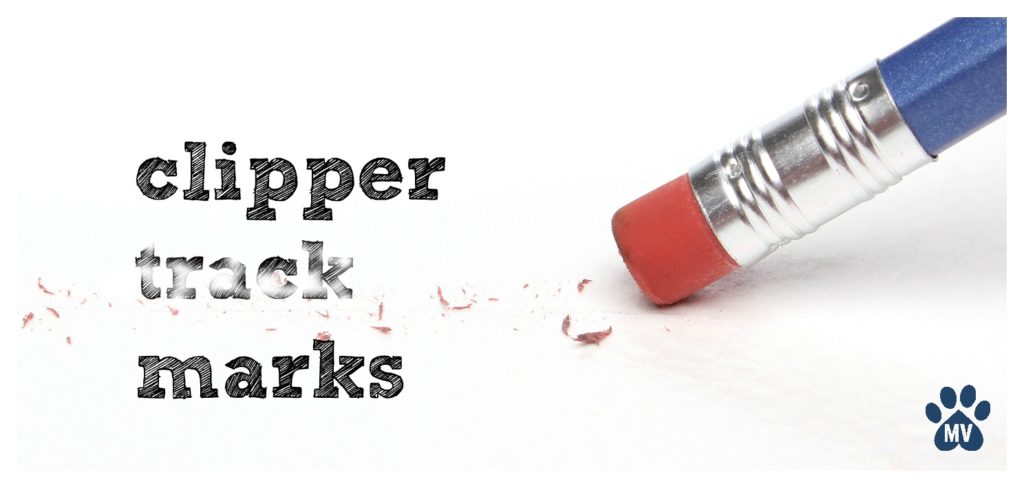 I was the assistant, doing mostly bathing and drying for the groomer. One day, she was overbooked and was falling deeply behind schedule. She had a basic “all trim” on a larger dog that she hadn’t even started yet. Out of desperation she asked if I would remove some of the coat before the bath.
I was the assistant, doing mostly bathing and drying for the groomer. One day, she was overbooked and was falling deeply behind schedule. She had a basic “all trim” on a larger dog that she hadn’t even started yet. Out of desperation she asked if I would remove some of the coat before the bath.
I thought to myself, “Sure, why not? How hard could it really be?” I picked up the A2 clipper as the groomer handed me the appropriate head. I twisted it on and set to work.
What a mess. The dog wasn’t hurt but my work was awful. The dog was full of uneven coat and lots of tracking.
The groomer had always made it look so easy. Coat seemed to melt off like a hot knife through butter. Her clipper work was always smooth and even. No track marks. No sticky-outies.
This was not nearly as easy as I thought!
However, I stuck with it.
 The groomer coached me as I struggled with the second side. It turned out somewhat better but was far from perfect. Today, I would not consider my work that day as acceptable – not even as pre-work before the bath. It was that bad! Luckily, I didn’t have to worry about all the tracking. It was just the rough cut before the bath. Once the dog was clean and blown dry, the groomer finished it in no time.
The groomer coached me as I struggled with the second side. It turned out somewhat better but was far from perfect. Today, I would not consider my work that day as acceptable – not even as pre-work before the bath. It was that bad! Luckily, I didn’t have to worry about all the tracking. It was just the rough cut before the bath. Once the dog was clean and blown dry, the groomer finished it in no time.
Fast forward 10 years. I had mastered the clippers and figured out how to eliminate tracking in the coat. On rare occasions, I still had problems. By that time, I was in my own mobile grooming van and running my own business. One of my clients was a buff American Cocker whose owners wanted clipper cut.
Most of you who have been groomers for any amount of time know some buff-colored Cockers track terribly when clipper cutting. This dog was no exception.
It didn’t matter what blade I chose.
Tracks.
It didn’t matter how powerful the clipper was.
Tracks.
It didn’t matter what time of year it was.
TRACKS.
The. Coat. ALWAYS. Tracked.
On one appointment, I basically threw my hands up. I could not get the tracking out of the coat. I had used all the tricks I knew to no avail. As I sat there contemplating how to remove the lines, I had an idea. What would happen if I reversed a blade over this coat? Hmmm. At that point, I figured I didn’t have much to lose.
I tried out the technique on an obscure spot on the dog’s body. I reversed a #7F blade then stepped back to check my work. I realized it was going to be way too short. I bumped up to a longer #4F blade. When I tried again – it was perfect. It was the length of a #7 blade. And even better, it was baby butt smooth. Eureka!
Over the years, I’d figured out how to get all coat types super smooth, but this Cocker type coat had always given me trouble. Once I mastered that coat type, coat tracking was a thing of the past for me.
So how do you get coat super smooth without any tracks?
There is not one simple answer but there are lots of techniques and trouble-shooting options. Here are a few tricks that I discovered with years of practice.
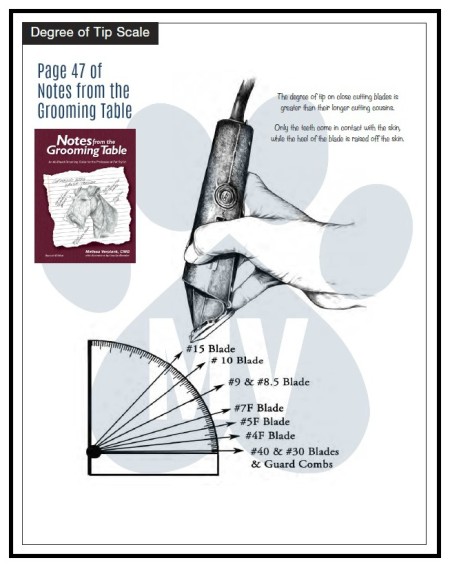 9 Ways to Eliminate Track Marks
9 Ways to Eliminate Track MarksEvery coat type is a little bit different. Some coats barely track at all. Others are almost impossible to get smooth. Learning how to minimize tracking takes time and practice. Mastering a smooth clipper cut in the least amount of time takes focus and attention to details.
There are a lot of moving parts when it comes to mastering clean perfect clipper work. Groomers who have mastered a track free simple “All Trim,” on a regular small to medium-sized can groom a pet in one hour or less.
If you struggle with this problem, my book, Notes from the Grooming Table, has a very detailed section about clipper work in the front of the book. My Learn2GroomDogs.com streaming video platform also has some great videos about efficient clipper work in the Core Video Category. Make sure to check out those two educational resources. If you work with a team of stylists, someone within your group might be able to coach and mentor you. You can also look for local clinics or workshops where you can work with a seasoned professional.
Happy trimming!
Melissa
 What are the tricks you’ve used to eliminate tracking? Jump on the Learn2GroomDogs.com Facebook page and tell us about it.
What are the tricks you’ve used to eliminate tracking? Jump on the Learn2GroomDogs.com Facebook page and tell us about it.
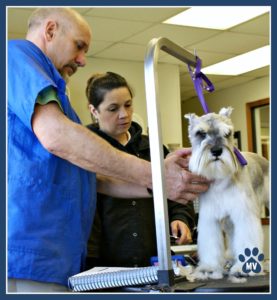 Learning to master skills helps us get ahead in our work and lives. To do this you need to have a deep understanding of the skill you are trying to perfect. You also need the dedication to put in the needed time and deliberate practice.
Learning to master skills helps us get ahead in our work and lives. To do this you need to have a deep understanding of the skill you are trying to perfect. You also need the dedication to put in the needed time and deliberate practice.
“Deliberate practice,” was introduced by researcher, Anders Ericsson who studied this concept for over 30 years. His research shows HOW you practice matters much more than HOW MUCH you practice.
Deliberate practice isn’t running a few miles each day, strumming a guitar for 20 minutes each morning, or grooming a few dogs each day. Deliberate practice is much more purposeful and focused. It might take you five to ten years of deliberate practice to truly master a skill.
To improve anything, you must push beyond your comfort zone. This process can be very difficult. Letting go of what is safe and learning to get comfortable with the unknown is hard for most of us. For some, it is impossible. But when you put sincere effort toward improving a weakness, you will grow.
To become great, experts focus on improving their weaknesses. Practicing on easy things never leads to improvement. Working hard just to work will exhaust you. Working purposefully towards improving is the secret to success.
It doesn’t matter whether you are trying to master a specific breed profile, specialize in a grooming technique, increase your speed, or skillfully run your business. To master any task, you need to focus and practice in a purposeful way.
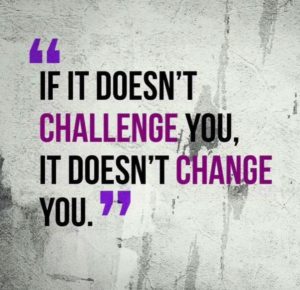 When I began a career with dogs, it didn’t take long before I knew I wanted to perfect my skills. I wanted to master pet grooming. I found mentors and coaches who could give me feedback. I read books. I studied images – photos of my own work as well as champions. I intently watched master pet stylists at work. I attended clinics and workshops. I tested my skills in the certification and competition rings. I always asked for feedback and focused on improving my work. I practiced. And practiced. And practiced.
When I began a career with dogs, it didn’t take long before I knew I wanted to perfect my skills. I wanted to master pet grooming. I found mentors and coaches who could give me feedback. I read books. I studied images – photos of my own work as well as champions. I intently watched master pet stylists at work. I attended clinics and workshops. I tested my skills in the certification and competition rings. I always asked for feedback and focused on improving my work. I practiced. And practiced. And practiced.
Today, I work with a business coach. Almost every week we have a 90-minute conference call. We focus on our weakest link and ways to improve it. The following week, we review what worked and what didn’t work – then move on to the next weak item on the agenda. Having a coach keeps me accountable, focused, and on track.
Remember – start small. Self-improvement can feel overwhelming. You can’t take on everything. If you do, you’ll feel defeated and never succeed at any of it. Instead, choose one or two skills to focus on at a time. Break down the skill into manageable chunks. Set goals. Get feedback and track your progress.
Along the learning journey, stop to reflect. When you want to move from good… to great… to mastery, you need to stop and spend time reflecting on what you’re doing. If you don’t, the new skill won’t stick. Talk to your mentor, coach, or someone you respect as you go. Talking about your progress assists in getting valuable feedback. It keeps you accountable and it cements the changes.
Be patient with yourself. You are not going to reach perfection right away. Mastery requires perfecting many smaller skills and then putting them all together. It could take months to perfect a single new sub-skill. It will take years to truly master a particular technique or specialize in a field.
You can use these techniques on anything you want to improve or master. Many of us can do something well. True mastery takes it to a much deeper level.
Do you have what it takes to become a master?
Happy trimming!
Melissa
 What are the things you’re working to perfect every day? Jump on the Learn2GroomDogs.com Facebook page and tell us about it.
What are the things you’re working to perfect every day? Jump on the Learn2GroomDogs.com Facebook page and tell us about it.
 Use coupon code aags2017 to get 25% off your new or renewed subscription from Learn2GroomDogs.com!
Use coupon code aags2017 to get 25% off your new or renewed subscription from Learn2GroomDogs.com!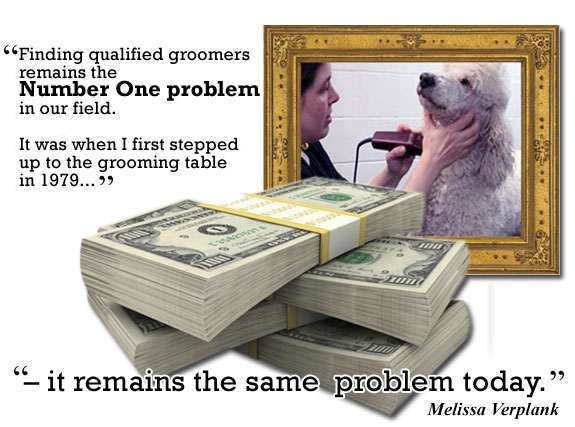
In my experience, the hardest part of running a business is STAFF!
Hands down the most challenging part of running a business is staffing it. Managing staff. Keeping staff. Paying staff. Keeping them accountable. Keeping them productive. Keeping them happy.
And the real biggie – training them.
So let’s tackle the training challenge first. It’s far easier to hire basic labor than filling a position that requires skill. At our kennel, the Whiskers Resort and Pet Spa, we have an endless supply of dog enthusiasts that want to work in the kennel. With multiple colleges within our community, the labor force is easy to come by. After all, everybody wants to play with puppies!
But what about those jobs that require skilled labor? People like receptionists, bathers, managers, and trainers.
One of the largest reasons I started the Paragon School of Pet Grooming was because I could not find qualified groomers to operate my fleet of mobile grooming vans. They just weren’t available. I still shudder when I think about it. There were times that I would have a van down for 6 to 12 months at a time before I could find somebody that could do the job. Not a very efficient way to run a business.
Working every day in a mobile grooming salon does not lend itself well to a training environment. It can work if you just have to add polish to a skilled professional. But to take them from scratch? Nope. It doesn’t work. You just can’t afford the time it takes to train a new groomer – especially if you rely on YOUR productivity to pay the bills. Starting a person from scratch to become a competent groomer in a mobile just does not work!
To get a groomer that can work independently – with safety and quality – will take months, not weeks, to train. After all, this is not a skill that you can quickly show somebody how to do. Grooming is not a simple task. It requires significant training.
I’ve heard some businesses offer two-week training programs for new hires. Then they turn them loose to groom “professionally.” Some circles might consider this enough, but for quality and safety, you need more.
Did you know the average person needs to see or hear something 3 to 7 times before it actually sinks in? And that’s for an average learner. Sure, star performers might pick it up after the first or second try – but those people are few and far between. Most of us fall in the average category. We have to see or do the same task repeatedly before we do it correctly.
I’ve been in the pet care industry for over 30 years – primarily in the grooming aspect of the industry. Finding qualified groomers remains the number one problem in our field.
 Finding talented grooming help was close to impossible was when I first stepped up to the grooming table in 1979 – and it remains the same problem today. I have chosen to focus on this critical problem. I own multiple companies in the pet industry. On the educational side, my companies aid in training and personal development for those stepping into the field for the first time as well as for aspiring pet groomers and stylists.
Finding talented grooming help was close to impossible was when I first stepped up to the grooming table in 1979 – and it remains the same problem today. I have chosen to focus on this critical problem. I own multiple companies in the pet industry. On the educational side, my companies aid in training and personal development for those stepping into the field for the first time as well as for aspiring pet groomers and stylists.
It has always been extremely easy to enter the field of pet grooming. There are very few regulations of any sort. Anybody can start bathing and cutting hair off a dog or cat, and call themselves a professional pet groomer. Those of us that have spent years perfecting our craft know it takes time and dedication to become confident and competent in all breed grooming. It takes years of practice and study.
Some of the ways that I have found to become a real professional include:
Even graduates coming out of quality grooming schools are not truly proficient. If they have graduated with above average GPA’s, they have given themselves a great foundation. It is the starting point of their career – but they are far from being a polished professional. They still need guidance. They still need coaching. They still need mentoring. They still need to study. And most of all – they need to practice A LOT!
 So let’s get back to that hiring challenge. If you’re faced with having to hire a groomer, know what to look for. One thing I recommend is Attitude. Attitude. Attitude. I always look for somebody who’s got a positive, upbeat attitude. Someone who is receptive to new information. They need to be moldable. Adaptable. And they cannot be afraid of hard work. I hire on potential, not necessarily experience.
So let’s get back to that hiring challenge. If you’re faced with having to hire a groomer, know what to look for. One thing I recommend is Attitude. Attitude. Attitude. I always look for somebody who’s got a positive, upbeat attitude. Someone who is receptive to new information. They need to be moldable. Adaptable. And they cannot be afraid of hard work. I hire on potential, not necessarily experience.
Once you have someone with a great attitude, helping them be best they can be is fun – and it can be very gratifying. Use the resources available to help them self-direct their own learning. It will take time, dedication, and patience before you see your new hire flourish but you can lighten your training load by taking advantage of many educational resources currently available. You might learn a thing or two yourself.
It amazes me that our industry has not advanced more in this area. Sure, there are more grooming schools than ever was before. Yes, there are certification organizations out there – but they’re still voluntary. Licensing, in some states is starting to catch on. However, we’re still a long way from having even a basic comprehensive licensing program in place for pet groomers and salon owners. The road before us is wide open with possibilities.
Will you help us blaze the trail?
Happy trimming!
Melissa
 What are the biggest training issues you see every day? Jump on the Learn2GroomDogs.com Facebook page and tell us about it.
What are the biggest training issues you see every day? Jump on the Learn2GroomDogs.com Facebook page and tell us about it.
As with all grooming techniques, there are many ways to get the job done.
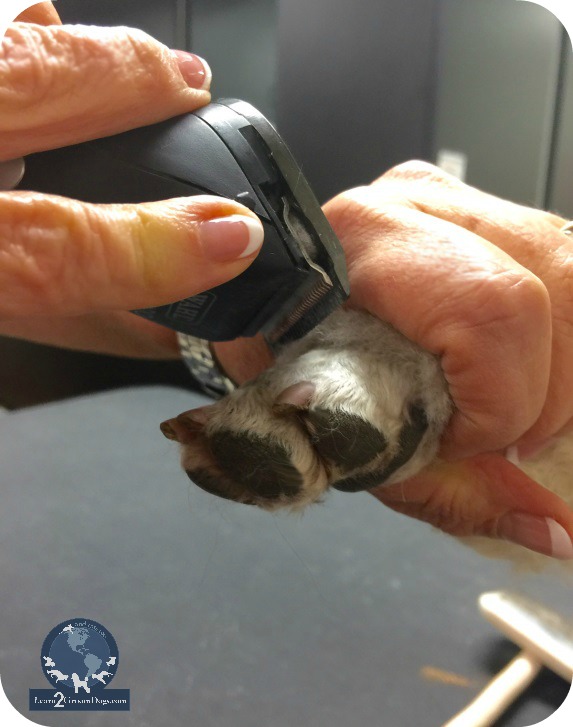 When I was a contest groomer, I always did my Poodle cuffs by hand. I would brush the coat down then give it a quick fluff with my comb. Once it was fluffed, I’d glide a long straight shear in and set the lower edge. Then I’d re-fluff and grab my long curved shears to round and bevel the edges. It was time-consuming.
When I was a contest groomer, I always did my Poodle cuffs by hand. I would brush the coat down then give it a quick fluff with my comb. Once it was fluffed, I’d glide a long straight shear in and set the lower edge. Then I’d re-fluff and grab my long curved shears to round and bevel the edges. It was time-consuming.
Done well, the beveled cuffs came out gorgeous. Done poorly, they were a sloppy mess. I had four chances to be perfect with my cuffs – or four chances to really mess up.
For pet dogs, I quickly taught myself another method. It was quick. Fool-proof. And it worked well on most of my shorter stylized pet trims.
On most of my pet trims, I cheated off excess leg hair by skimming it with a guard comb. Not only was it fast – it helped me set the length, too. Once I had the legs roughed in, I would brush the leg coat over the clipped foot with a firm slicker brush. I would slide my hand down the leg with my thumb and first finger resting just below the clipper line on the Poodle foot. My fingers would be my guide as I slid in a small pair of detailing scissors (I choose small shears for the safety of my own fingers!). I would scissor all the way around the cuff line, removing the longer hair.
When I released the coat… voila! A perfect cuff for an active pet. I could adjust the fullness of the beveled cuff by adjusting my scissored line somewhere between the lines of the knuckles of the foot and just below the clipped line on the foot. The lower I was on the foot with my cuff line, the fuller the bevel.
 Once my cuff was set, I would neaten and finish the entire leg with shears, smoothing out my guard comb work.
Once my cuff was set, I would neaten and finish the entire leg with shears, smoothing out my guard comb work.
I used this method for years. I even started to incorporate it into my more polished work in the contest ring. It worked well there, too – especially if I used it as a double-check after I did my cuffs with longer shears.
In the past few years, I’ve seen extremely talented stylists start using another method to get perfect cuffs every time. They use a #30 or #40 blade on their clippers! Who knew?
So how do you do it?
It’s very similar to my old method, but instead of shears, pet stylists reach for their cordless 5 in 1 style clipper. They set the blade at the shorter levels, basically the length of a #30 or #40 blade.
Hold the foot off the table at a comfortable level for the pet. With a firm slicker brush, brush all the hair down around the foot. Once the coat is brushed into place, slide your hand down the pet’s leg, thumb and forefinger closest to the foot.
 Stop and hold the foot with your fingers coming to rest right at the clipped cuff line. While maintaining your hold on the foot, gently trim at right angles around the cuff with the #30 or #40 blade. Simply touch the coat at the edge line you want to set.
Stop and hold the foot with your fingers coming to rest right at the clipped cuff line. While maintaining your hold on the foot, gently trim at right angles around the cuff with the #30 or #40 blade. Simply touch the coat at the edge line you want to set.
The fullness of the leg coat will determine where you place the line. For fuller legs, use the top of the crease marks on the toes. If the leg coat is shorter, move the line closer to the clipped cuff line.
When you release the coat, the fur will be nicely beveled. The line should be crisp and free of all stray hairs. As with the hand-scissored cuff, check the work from all angles to make sure the cuffs are level from side to side and front to back. Don’t forget to look from table level when inspecting your cuffs for perfection.
It may take a few tries to perfect this technique, but once you do, creating flawless cuffs every time becomes simple. With a well-prepped dog, this technique is fun, fast, and super safe.
Happy trimming!
Melissa
 Did you try it? How did it work for you? Jump on the Learn2GroomDogs.com Facebook page and tell us what works for you!
Did you try it? How did it work for you? Jump on the Learn2GroomDogs.com Facebook page and tell us what works for you!

Unfortunately, there isn’t an easy rule for solving the problems of tardy or no-show clients. The good news is that you have lots of options to help deal with it. Depending on how busy you are, cancellations can either be a blessing or a curse. In either case, if you have a client who is chronically dismissive or disrespectful of your time, you need to be proactive and correct the problem.
Our kennel, Whiskers Resort and Pet Spa, experienced 68 reservation cancellations over the 4th of July holiday. During the summer months, Whiskers runs at over 100% occupancy rate with its 180 rooms. During peak holidays such as Thanksgiving, Christmas, New Year’s, and Spring Break, Whiskers charges a $50 deposit for all reservations. This deposit is nonrefundable if the cancellation takes place two weeks prior to their check-in date. In the past, the deposit has not been charged for Memorial Day, the Fourth of July, or Labor Day. That will be changing.
For years we’ve tracked grooming appointment cancellations at The Paragon School of Pet Grooming. Despite our continual efforts to knock the rate down, its remains a persistent 10%.

In the pet grooming industry, time is money. Clients who are chronically tardy or don’t show up for their appointments create havoc for both your schedule and your pocketbook.
It’s frustrating.
It’s disrespectful.
It’s rude.
(However, if you are overbooked, it can also be a blessing.)
There is no perfect solution for this problem. Everyone has a slightly different take on this situation. Some salons run on a very tight schedule while others are more relaxed. And let’s face it, there are times when the client has a legitimate excuse. So, what do you do?
 Are there exceptions to your rules? Absolutely.
Are there exceptions to your rules? Absolutely.
If you don’t already track how many cancellations you have each day and each week – start tracking it. Find out what your cancellation average is per day. Once you know the number, you can be proactive in correcting the problem.
Another way to look at it is from a dollar standpoint. At Paragon, our average cancellation rate is 10%. If you apply the 10% rate to your situation and you do 20 dogs a day at $50, that starts to add up! That translates into losing two dogs or $100 every day! Times that by five days a week and you’re at $500 of lost revenue. To me, it’s worth taking the time to simply call and remind people of their upcoming appointment the day before!
We are in the business of building positive relationships with our customers, both the two-legged and four-legged variety. Your personality and the type of relationship with your clients dictates how firmly you adhere to the demands on your time. Remember, these customers not only affect you and your time, they ultimately affect your schedule and your other clients. You need to be warm, caring, and maintain your professionalism.
Just because you are warm and caring does not mean you can’t set rules and boundaries. Remember, you can still provide great customer service and have a mutually respectful relationship that benefits both you and your client.
Happy trimming!
Melissa
 How do you deal with this issue? Jump on the Learn2GroomDogs.com Facebook page and tell us what works for you.
How do you deal with this issue? Jump on the Learn2GroomDogs.com Facebook page and tell us what works for you.